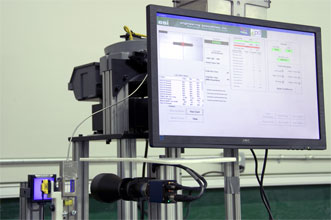Oct. 9, 2015 — For those who question how much a picture is worth, consider the experience of Engineering Specialties, Inc. (ESI). Getting a complete image is crucial to the company’s success.
Based in North Branford, Conn., ESI is a metal stamping and assembly company. For its assembly applications, ESI uses custom-built machines to put, for example, a rubber or plastic part on a screw or a bolt’s shaft. Typically, the assemblies are only a small part of a much bigger end product.
ESI does a lot of work for the automotive industry. And, like the old saying about the lack of a nail leading to the loss of a kingdom, not having the right part — even if it’s small — can have a big effect.
For instance, Carmen Ciardiello, the company’s vice president of engineering, noted a small pin ESI manufactures that’s used in a seat belt retractor. That pin plays a part in making the seat belt work properly — and pictures obtained via a vision system help ensure that happens.

A vision-based inspection machine that takes 250 milliseconds to look at 10 different part characteristics on a small pin used in a seat belt retractor. Photo courtesy of Engineering Specialties Inc.
“The vision system inspects 10 different part characteristics in 250 milliseconds. We make 30 million of these a year and inspect 100 percent of the parts. We have never had one part rejected from our customer … all due to the vision system,” Ciardiello said.
Using the vision system to make sure the parts meet specifications is important not only to the customer but to ESI, as well. For the customer, this ensures the assembly line keeps moving. It also helps keep warranty and other repair rates, as well as customer complaints, at acceptable levels. For ESI, having the data from the inspection is important. If the results suddenly show a rising tide of parts being rejected, then that indicates an issue with the machine making the pins, or an issue elsewhere within the manufacturing process. Knowing that as soon as possible means that any necessary repairs can be started and completed as early as possible — a goal both ESI and its customers share.
Regarding the vision system itself (as discussed in “Choosing a Machine Vision System — Making the Right Selection”) it’s a tool. That means the right vision system for one job may not be as right (and may even be wrong) for another job. So, sometimes ESI uses a general-purpose, PC-based system and, at other times, uses a smart camera for a more application-specific approach. The first type generally is more powerful but can require significant engineering time to get running. Conversely, something application specific in nature typically is easy to configure. However, it’s probably not the right choice when complicated measurements and checks are needed.
In the case of the automated inspection system that scrutinizes the pins — that’s a general-purpose system, according to Ciardiello. In the future, though, a different tool, a more application-specific one, might be the right choice.
That’s because, in an update to the old saying regarding time and tide, the march of technology waits for no one. That means the right tool to use to get the whole picture changes with time. This can be seen in the growing capabilities and dropping prices of smart cameras. “It’s going to make them more and more attractive,” Ciardiello said.